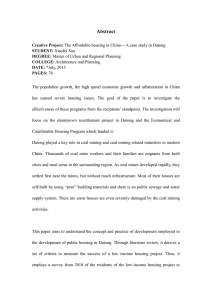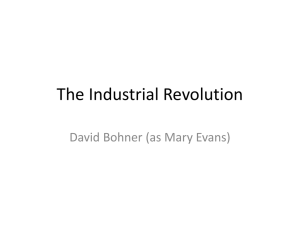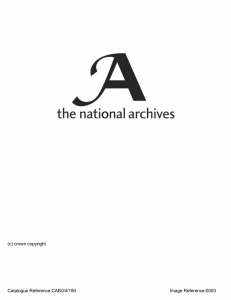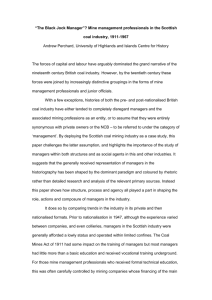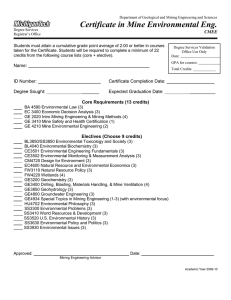International Journal of Application or Innovation in Engineering & Management... Web Site: www.ijaiem.org Email: ISSN 2319 – 4847
advertisement
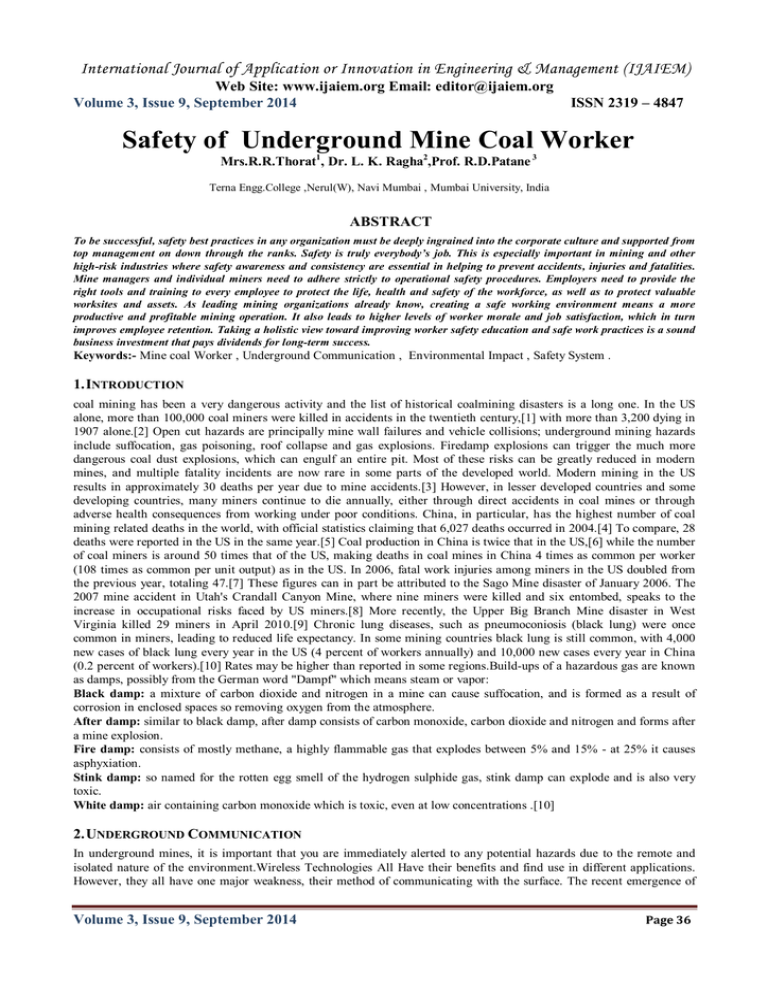
International Journal of Application or Innovation in Engineering & Management (IJAIEM) Web Site: www.ijaiem.org Email: editor@ijaiem.org Volume 3, Issue 9, September 2014 ISSN 2319 – 4847 Safety of Underground Mine Coal Worker Mrs.R.R.Thorat1, Dr. L. K. Ragha2,Prof. R.D.Patane 3 Terna Engg.College ,Nerul(W), Navi Mumbai , Mumbai University, India ABSTRACT To be successful, safety best practices in any organization must be deeply ingrained into the corporate culture and supported from top management on down through the ranks. Safety is truly everybody’s job. This is especially important in mining and other high-risk industries where safety awareness and consistency are essential in helping to prevent accidents, injuries and fatalities. Mine managers and individual miners need to adhere strictly to operational safety procedures. Employers need to provide the right tools and training to every employee to protect the life, health and safety of the workforce, as well as to protect valuable worksites and assets. As leading mining organizations already know, creating a safe working environment means a more productive and profitable mining operation. It also leads to higher levels of worker morale and job satisfaction, which in turn improves employee retention. Taking a holistic view toward improving worker safety education and safe work practices is a sound business investment that pays dividends for long-term success. Keywords:- Mine coal Worker , Underground Communication , Environmental Impact , Safety System . 1. INTRODUCTION coal mining has been a very dangerous activity and the list of historical coalmining disasters is a long one. In the US alone, more than 100,000 coal miners were killed in accidents in the twentieth century,[1] with more than 3,200 dying in 1907 alone.[2] Open cut hazards are principally mine wall failures and vehicle collisions; underground mining hazards include suffocation, gas poisoning, roof collapse and gas explosions. Firedamp explosions can trigger the much more dangerous coal dust explosions, which can engulf an entire pit. Most of these risks can be greatly reduced in modern mines, and multiple fatality incidents are now rare in some parts of the developed world. Modern mining in the US results in approximately 30 deaths per year due to mine accidents.[3] However, in lesser developed countries and some developing countries, many miners continue to die annually, either through direct accidents in coal mines or through adverse health consequences from working under poor conditions. China, in particular, has the highest number of coal mining related deaths in the world, with official statistics claiming that 6,027 deaths occurred in 2004.[4] To compare, 28 deaths were reported in the US in the same year.[5] Coal production in China is twice that in the US,[6] while the number of coal miners is around 50 times that of the US, making deaths in coal mines in China 4 times as common per worker (108 times as common per unit output) as in the US. In 2006, fatal work injuries among miners in the US doubled from the previous year, totaling 47.[7] These figures can in part be attributed to the Sago Mine disaster of January 2006. The 2007 mine accident in Utah's Crandall Canyon Mine, where nine miners were killed and six entombed, speaks to the increase in occupational risks faced by US miners.[8] More recently, the Upper Big Branch Mine disaster in West Virginia killed 29 miners in April 2010.[9] Chronic lung diseases, such as pneumoconiosis (black lung) were once common in miners, leading to reduced life expectancy. In some mining countries black lung is still common, with 4,000 new cases of black lung every year in the US (4 percent of workers annually) and 10,000 new cases every year in China (0.2 percent of workers).[10] Rates may be higher than reported in some regions.Build-ups of a hazardous gas are known as damps, possibly from the German word "Dampf" which means steam or vapor: Black damp: a mixture of carbon dioxide and nitrogen in a mine can cause suffocation, and is formed as a result of corrosion in enclosed spaces so removing oxygen from the atmosphere. After damp: similar to black damp, after damp consists of carbon monoxide, carbon dioxide and nitrogen and forms after a mine explosion. Fire damp: consists of mostly methane, a highly flammable gas that explodes between 5% and 15% - at 25% it causes asphyxiation. Stink damp: so named for the rotten egg smell of the hydrogen sulphide gas, stink damp can explode and is also very toxic. White damp: air containing carbon monoxide which is toxic, even at low concentrations .[10] 2. UNDERGROUND COMMUNICATION In underground mines, it is important that you are immediately alerted to any potential hazards due to the remote and isolated nature of the environment.Wireless Technologies All Have their benefits and find use in different applications. However, they all have one major weakness, their method of communicating with the surface. The recent emergence of Volume 3, Issue 9, September 2014 Page 36 International Journal of Application or Innovation in Engineering & Management (IJAIEM) Web Site: www.ijaiem.org Email: editor@ijaiem.org Volume 3, Issue 9, September 2014 ISSN 2319 – 4847 the sensor networks technology is significantly impacting the capabilities for automated distributed monitoring of environments. The low manufacturing cost of sensors, increased coverage and accuracy in distributed sensing due to their large deployments and their ability to operate in inhospitable terrains has made them an amenable technology for various surveillance and monitoring applications. In this paper,we are focusing on the safety issues of mine coal workers. 3. SAFETY SYSTEM Trolex systems can be supplied with an audible and visual alarm which will instantly draw your attention to a problem. The underground safety systems provide live data feedback both below and above ground, while each sensing element comes with its own processor for data storage. This allows you to monitor changes that could affect the safety of your mine environment or mining machinery over time, reducing maintenance and unplanned downtime, while improving its overall efficiency and production output. Our mining safety systems can include Fixed gas detection systems - a gas detector can monitor flammable and toxic gases, including methane, carbon monoxide and CO2. We can monitor a full range of different gases at different sensitivity levels. Environmental monitoring - air and gas flow, temperature and pressure sensors measuring changes to your mining operations make sure that conditions remain safe. Machine condition monitoring - through monitoring machinery, you can make sure that your valuable equipment remains safe and efficient.[11] 4. ENVIRONMENTAL IMPACT OF THE COAL INDUSTRY Coal mining can result in a number of adverse effects on the environment. Surface mining of coal completely eliminates existing vegetation, destroys the genetic soil profile, displaces or destroys wildlife and habitat, degrades air quality, alters current land uses, and to some extent permanently changes the general topography of the area mined,[12]This often results in a scarred landscape with no scenic value. Rehabilitation or reclamation mitigates some of these concerns and is required by US Federal Law, specifically the Surface Mining Control and Reclamation Act of 1977. Mine tailing dumps produce acid mine drainage which can seep into waterways and aquifers, with consequences on ecological and human health. If underground mine tunnels collapse, this can cause subsidence of land surfaces. During actual mining operations,methane, a known greenhouse gas, may be released into the air. And by the movement, storage, and redistribution of soil, the community of microorganisms and nutrient cycling processes can be disrupted. The coal industry takes the issue of safety very seriously; WCA members strive for a goal of zero fatalities and publish statistics for both fatal and non-fatal accidents in their annual reports. The WCA's "Commitment to Safety" policy statement demonstrates the critical importance the coal industry places on safety in its operations. The safety of workers should always be a primary consideration in any form of coal mining. Coal mining deep underground involves a higher safety risk than coal mined in opencast pits, due primarily to problems associated with mine ventilation and the potential for mining collapse. However, there are safety risks associated with all forms of coal mining, not least because of the heavy machinery utilised in coal excavation. Mining explosions are a particularly prevalent safety risk in underground mining. Methane released from the coal seam and surrounding rock strata during the process of mining can present a high risk of explosion at concentrations in air of 5-15%. Techniques have been developed to eliminate and/or dilute methane emissions both prior to and during mining and this has helped to significantly reduce methane related explosions in underground mines. Modern coal mines have rigorous safety procedures, health and safety standards and worker education and training, which have led to significant improvements in safety levels in both underground and opencast mining. However, there are still problems within the industry. Safety in coal mining in China is a critical issue. The number of fatalities is unacceptably high, particularly due to the number of unregulated small coal mines that have operated in recent years. The Chinese authorities recognise this and are working hard to improve their performance, closing unsafe mines and promoting best practice. Major coal mining companies in the west are receiving a growing number of delegations from the Chinese coal mining sector together with government officials anxious to learn and to implement proven safe practices. The top Chinese coal mining companies have a safety record comparable to the best elsewhere in the world and they provide an important platform within the country to further advance the implementation of safe mining practices.[12] 5. SAFETY MEASURE TO REDUCE RISK Fortunately modern equipment, more automated mining techniques, and better mine engineering have significantly reduced some of these safety risks, leading global mine operators to incorporate rigorous safety procedures and health and safety standards, while taking a proactive approach to worker education and training. While improvements have been Volume 3, Issue 9, September 2014 Page 37 International Journal of Application or Innovation in Engineering & Management (IJAIEM) Web Site: www.ijaiem.org Email: editor@ijaiem.org Volume 3, Issue 9, September 2014 ISSN 2319 – 4847 made and much more is known about the dangers and the risks, it makes sense to periodically evaluate your safety strategy to ensure you’re doing all you can to provide the safest, most up-to-date work environment possible. While the list below may seem obvious, it never hurts to revisit your safety program. Here’s a checklist of reminders to consider when re-evaluating your safety program for an underground mine. Illumination For general tunneling operations, the MHSA requires a minimum illumination intensity of 5 foot-candles, although 10 foot-candles must be provided for shaft heading during drilling, mucking and scaling. Check all lamps regularly. Hazard Signage Check all signage to make sure it’s highly visible and legible. Communications Make sure all telephones and other signaling devices are fully operational at all times. These devices can be critical in the event of an unexpected incident or accident. Equipment Maintenance Routine equipment checks and maintenance programs ensure that equipment and vehicles used in the mine or on the mining site are performing properly and reliably, and do not pose any dangers to their operators or workers nearby. Fall Protection While typically not a major issue in underground mines, working at different heights is sometimes required in mountainous mines or raised goldmines where ladders and scaffolds are needed. In these situations, make sure you have the proper harnesses, belts and other safeguards to prevent falling. Ventilation and Alarm Systems Air quality sensors and alarms should be in top working order and able to detect irregular levels of Carbon Monoxide (CO) and other potentially toxic fumes, vapors and gases. Make sure you have a regularly scheduled maintenance and testing plan for this equipment. Worker Identification and Check-In Check-Out Systems Mine operators must know the location of every worker at every moment of each shift. Double-check your worker identification and check-in/check-out system. Emergency and Evacuation Plans Periodic disaster evacuation drills and testing emergency communication and signaling systems prepares workers on what to do if there’s an emergency. Emergency gear, such as HAZMAT suits and breathing apparatusshould be available for first responders and rescue teams. Personal Protective Equipment (PPE) Experienced miners know what gear they need to prevent or at least minimize injuries on the job. For newcomers, however, it’s important to include information on selecting PPE in their training. Manufacturers of PPE have made significant improvements in the materials they use. Take a look at what you’re using for PPE. It might be time for change. Protective Clothing This may include rain gear, head gear, high-visibility jackets and coveralls, flash-rated, all-cotton coveralls and clothing with reflective stripes such as those worn by bikers and runners. Work Gloves Special tasks require specific gloves. Today’s glove manufacturers have made significant improvements in glove designs, using lighter-weight and more breathable fabrics. Some if these materials even offer better cut and puncture resistance. Take a look at the gloves your workers are using. There may be better options available. Footwear Enhancements in footwear have made industrial footwear even better. Today’s work boots are higher to prevent ankle rollover. Specially insulated boots can protect feet in both extreme cold and heat. Sole platforms are now wider and thicker to provide surer footing and better balance. Eye Protection In addition to LED-lighted hard hats, many miners require safety glasses. Today’s eyewear designs include improved scratch abrasion and fog resistance. Hearing Protection Mine blasting and excessive noise generated by diesel-powered equipment can cause lasting damage to miners’ hearing. Hearing protection in the form of earplugs and coverings can be used, depending on the ambient decibel levels in work areas. Safety is truly everybody’s job. This is especially important in mining and other high-risk industries where safety awareness and consistency are essential in helping to prevent accidents, injuries and fatalities. Mine managers and individual miners need to adhere strictly to operational safety procedures. Employers need to provide the right tools and training to every employee to protect the life, health and safety of the workforce, as well as to protect valuable worksites and assets. As leading mining organizations already know, creating a safe working environment means a more productive and profitable mining operation. It also leads to higher levels of worker morale and job satisfaction, which in turn improves employee retention. Taking a holistic view toward improving worker safety education and safe work practices is a sound business investment that pays dividends for long-term success. [13][14][15][16] 6. SAFETY OF MINE COAL WORKER IN INDIA The government has announced ten measures to improve the safety of workers in coal mines. Minister of State for Power, Coal and New and Renewable Energy (Independent Charge) in a written reply to a question in the RajyaSabha said today that the safety measures are as follows: Volume 3, Issue 9, September 2014 Page 38 International Journal of Application or Innovation in Engineering & Management (IJAIEM) Web Site: www.ijaiem.org Email: editor@ijaiem.org Volume 3, Issue 9, September 2014 ISSN 2319 – 4847 (i) To promote and propagate safety awareness in mines, National Safety Awards (Mines) and National Conference on Safety in Mines are organized by DGMS. The recommendations of National Conference on Safety in Mines are being implemented to enhance safety of mine workers. (ii) Workers participation and sensitization in matters of safety are ensured through training in safety and by initiatives like celebration of safety week and safety campaigns, etc. (iii) Safety training programmes are organized among Managers and Supervisors for improving safety standards in mines. (iv) Risk assessment techniques are being introduced which aim to eliminate, control and manage the personal risks in mines. (v) Standard operating procedures are established to avoid unsafe practices in mines. (vi) A special safety awareness campaign has been launched to increase awareness of mine workers. i.e., 'Safety is My Responsibility' and steps have been taken to propagate this to each miner. (vii) Other safety measures initiated recently: Special training programme for safety officers and other key mining official directly engaged in ensuing safety at mines by SIMTARS, Australia accredited trainers. Several R and D projects on safety have also been initiated. Spreading knowledge and coal mine safety information through publication of quarterly safety bulleting. (viii) Internal safety organizations of coal companies regularly visit the mines for assessing the safety status and advise the management for corrective steps required if any. (ix) Coal companies also conduct safety audits through engaging experts in mine safety and take appropriate corrective measures for improving safety in mines. (x) Standing Committee on Safety in Coal Mines under the Chairmanship of Minister of Coal periodically reviews the status of safety in coal mines in the country and issues are addressed for ensuring safety of persons deployed in coal mines.[18] 7. CONCLUSION In underground mines, it is important that you are immediately alerted to any potential hazards due to the remote and isolated nature of the environment. Trolex systems can be supplied with an audible and visual alarm which will instantly draw your attention to a problem. The underground safety systems provide live data feedback both below and above ground, while each sensing element comes with its own processor for data storage. This allows you to monitor changes that could affect the safety of your mine environment or mining machinery over time, reducing maintenance and unplanned downtime, while improving its overall efficiency and production output. REFERENCES [1.] [2.] [3.] [4.] [5.] [6.] [7.] ^"Former Miner Explains Culture Of Mining." NPR: National Public Radio. April 7, 2010. Jump up^ "Coal Mining Steeped in History". ABC News. January 5, 2006. Jump up^ OccupationalHazards.com."Respiratory Protection in Coal Mines." Jump up^ Deconstructing deadly details from China's coal mine safety statistics | CLB Jump up^ US Mine Safety and Health Administration. "Statistics - Coal Mining Fatalities by State - Calendar Year." Jump up^ World Coal Institute - Coal Production Jump up^ "Census of Fatal Occupational Injuries Summary, 2006 Washington D.C.: U.S. Department of Labor". Bureau of Labor Statistics. (2006). [8.] Jump up^ "Panel to Explore Deadly Mine Accident". New York Times. Associated Press. September 4, 2007. [9.] Jump up^ Urbina, Ian (2010-04-09). "No Survivors Found After West Virginia Mine Disaster". New York Times. [10.] Jump up^ Abelard.org, "Fossil fuel disasters" [11.] http://de.trolex.com/systems/categories/underground-safety#sthash.ygBPo72Y.dpuf [12.] ^ U.S. Department of the Interior. 1979.Permanent Regulatory Program Implementing Section 501(b) of the Surface Mining Control and Reclamation Act of 1977: Environmental Impact Statement. Washington, D.C.: U.S. Department of the Interior. [13.] “Good Practice Guidance on Occupational Health Risk Assessment.” International Council on Mining & Metals. February 25, 2010. [14.] BP. BP Statistical Review of World Energy. June 2012. bp.com/statisticalreview [15.] U.S. Department of Labor s Mining Health & Safety Administration (MHSA).http://www.msha.gov/OSHA. [16.] www.osha.gov. Volume 3, Issue 9, September 2014 Page 39 International Journal of Application or Innovation in Engineering & Management (IJAIEM) Web Site: www.ijaiem.org Email: editor@ijaiem.org Volume 3, Issue 9, September 2014 ISSN 2319 – 4847 [17.] http://www.worldcoal.org/resources/coal-statistics/ http://www.iea.org/Posted in: Fall Protection, Mining Safety Equipment, PPE, Safety, Coal Mine Safety, Underground Mines, Ventilation In Mining, Workplace Safety [18.] http://www.dnaindia.com/india/report-government-introduces-ten-measures-to-improve-safety-of-coal-mineworkers-200789 9 AUTHOR Mrs.R.R.Thorat received Diploma in Industrial Electronics from RPW,Loni and received BE(Electronics) from North Maharashtra University,Now she is persuing ME(Electronics) from Terna Engineering College,Mumbai University and working as a Lecturer in Terna Polytechnic, Navi Mumbai from 9 year. L.K.Ragha received the B.E. degree in Electronics & communication Engineering from University of Mysore and M.E. degree in Digital Electronics from Karnatak University in 1985 and 1997 respectively.He earned his Doctorate degree in Electronics Engineering in the year 2010 from University of Mumbai, India. He is with the Department of Electronics and Telecommunication Engineering, Terna Engineering College, Navi-Mumbai as Professor.His current research interests are dosimetric aspects of the interaction between electromagnetic fields and biological systems, medical applications of electromagnetic fields, and numerical techniques. He is member of many professional bodies. He has published several papers on diverse topics in refereed journals. R.D.Patane is working as Associate Professor & HOD in the department of General Engineering in TernaEngineering,Nerul,NaviMumbai,India. Volume 3, Issue 9, September 2014 Page 40
